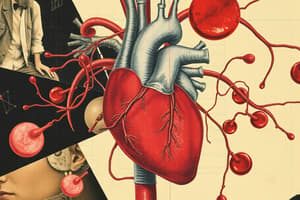Podcast
Questions and Answers
What are the functions of the circulatory system?
What are the functions of the circulatory system?
Blood is transported through the blood vessels delivering nutrients and oxygen to all body cells.
What are the functions of the respiratory system?
What are the functions of the respiratory system?
Group of organs that takes in oxygen from air, transfers it to the blood, and removes waste.
How do the lungs and heart work together to provide oxygen to cells?
How do the lungs and heart work together to provide oxygen to cells?
The heart works as a pump allowing air into the lungs and releasing waste from the body.
What are the major organs of the respiratory system?
What are the major organs of the respiratory system?
What are the major organs of the circulatory system?
What are the major organs of the circulatory system?
What part of the respiratory system helps trap particles like dust?
What part of the respiratory system helps trap particles like dust?
What are the functions of arteries and veins?
What are the functions of arteries and veins?
What is the most important air component that goes into the lungs?
What is the most important air component that goes into the lungs?
What is the only vein that carries oxygen-rich blood?
What is the only vein that carries oxygen-rich blood?
What is the only artery that carries oxygen-poor blood?
What is the only artery that carries oxygen-poor blood?
What is the purpose of valves in veins and in the heart?
What is the purpose of valves in veins and in the heart?
What causes a pulse?
What causes a pulse?
What is pulmonary circulation?
What is pulmonary circulation?
What is coronary circulation?
What is coronary circulation?
What is systemic circulation?
What is systemic circulation?
Why are capillaries only one cell thick?
Why are capillaries only one cell thick?
Where does oxygen in your alveoli come from?
Where does oxygen in your alveoli come from?
What leaves the blood in the lungs?
What leaves the blood in the lungs?
What is the role of hemoglobin?
What is the role of hemoglobin?
What links arteries and veins together?
What links arteries and veins together?
What is transported in red blood cells?
What is transported in red blood cells?
What part of the blood makes blood clotting possible?
What part of the blood makes blood clotting possible?
Why do cells need oxygen?
Why do cells need oxygen?
Why is blood leaving the body bright red while blood entering the lungs is dark red?
Why is blood leaving the body bright red while blood entering the lungs is dark red?
What is the function of white blood cells?
What is the function of white blood cells?
What is the function of red blood cells?
What is the function of red blood cells?
What is the function of platelets?
What is the function of platelets?
What is the function of plasma?
What is the function of plasma?
Flashcards are hidden until you start studying
Study Notes
Circulatory System Functions
- Transports blood through vessels to deliver nutrients and oxygen to all body cells.
- Maintains homeostasis by regulating temperature and pH levels.
- Removes waste products from cellular metabolism.
Major Components of the Circulatory System
- Organ structures include arteries, veins, capillaries, and heart.
- Arteries: carry oxygen-rich blood away from the heart; veins: return oxygen-poor blood to the heart.
Heart and Lung Interaction
- The heart acts as a pump, supplying blood to the lungs for oxygenation and removing carbon dioxide.
- Pulse is caused by the heartbeat, indicating blood flow.
Circulatory Pathways
- Pulmonary Circulation: Flow of blood from the heart to the lungs and back; oxygen is picked up, and carbon dioxide is released.
- Coronary Circulation: Supplies blood to the heart tissue itself.
- Systemic Circulation: Distributes oxygen-rich blood to all body tissues (excluding heart and lungs).
Capillaries and Gas Exchange
- Capillaries, which connect arteries and veins, are only one cell thick, facilitating gas and nutrient exchange.
- Oxygen in alveoli originates from the atmosphere; carbon dioxide leaves the blood in the lungs.
Blood Composition and Functions
- Red Blood Cells (RBCs): Transport oxygen from lungs to body cells and carry some carbon dioxide back to the lungs; hemoglobin in RBCs is responsible for oxygen binding.
- White Blood Cells (WBCs): Play a critical role in the immune response by fighting infections and bacteria.
- Platelets: Essential for blood clotting processes to prevent hemorrhage.
- Plasma: Liquid component of blood, primarily water, containing dissolved nutrients, minerals, and oxygen.
Unique Blood Properties
- Pulmonary Vein: The only vein that carries oxygen-rich blood.
- Pulmonary Artery: The only artery that carries oxygen-poor blood.
- Blood color changes from bright red (oxygen-rich) to dark red (oxygen-depleted) depending on oxygen saturation levels.
Importance of Oxygen in Cellular Function
- Cells require oxygen to produce energy and function effectively; lack of oxygen can lead to cell death.
Studying That Suits You
Use AI to generate personalized quizzes and flashcards to suit your learning preferences.



